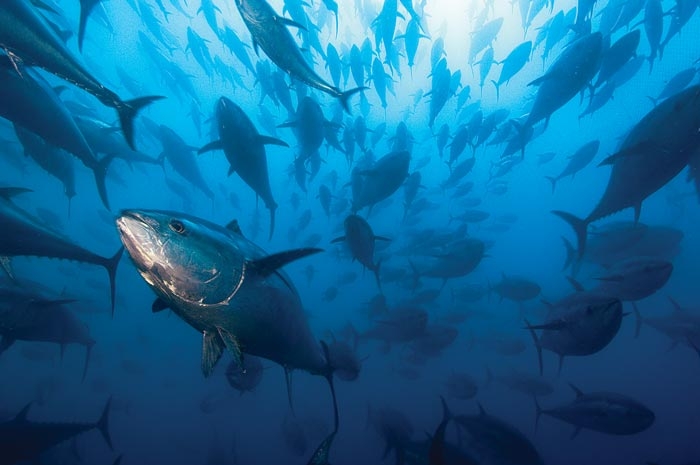HAVING PROVEN THEIR VALUE VIA COLLABORATIVE PILOT PROJECTS, ELECTRONIC MONITORING SYSTEMS MUST NOW BE STANDARDIZED ACROSS FISHERIES. HOW TO GO ABOUT THAT IS ON THE AGENDA AS SCIENTISTS GATHER THIS MONTH TO ASSESS, ANALYZE AND PROBLEM SOLVE FOR THE PROTECTION OF ONE OF THE PACIFIC’S MOST IMPORTANT RESOURCES.
By Victor Restrepo
1 August 2016
Throughout the world, advanced technology is increasingly used to provide solutions to the practical challenges of sustainable, modernfisheries management once thought insurmountable. From the eradicationof illegal, unreported and unregulated (IUU) fishing to improved datacollection for better resource management overall, there _is_generally “an app for that.”
Consider electronic monitoring systems or EMS. In the world’slargest tuna fishing grounds — the Western and Central Pacific Ocean— the use of EMS is expanding. On board fishing vessels, EMS camerasand sensors can record fishing activities as well as collect andarchive accurate facts and figures. For purse seine vessels that catchtuna, EMS can provide reliable data on the details of each fishingactivity, including time, location, catch, discards and non-targetspecies caught. Ultimately, this kind of detailed information canchange how fisheries are monitored and managed for the better.
With these facts and features proven, thanks to many collaborativepilot projects in the Pacific and beyond, we are now at a crucialjuncture for EMS. Fisheries scientists and managers must consider howto get the most from this promising technology. And we can look topast experience to guide us. Parallels with human observer programs,created decades ago and still one of the best tools for modernfisheries monitoring, are instructive.
With human observer programs, the observers themselves are one of manyelements that comprise a successful program. As they established andthen evolved these tools, countries needed to set robust standards forhow those observers collected and debriefed data, generated reports,and created databases, as well as set national regulations for usingobserver-generated data for compliance and management. Likewise,developing consistent and universal standards and protocols for EMS isimperative for a fully realized program.
Speaking of human observers, we must acknowledge just how far thisworkforce and program has advanced science-based conservation effortsin the world’s tuna fisheries. These experts serve as eyes and earson the water, recording key information on fishing activitiesincluding data on catch, effort and bycatch, and assist withmonitoring compliance — keeping scientists, fisheries managers, flagstates, and coastal states in the know. Still, conditions for humanobservers are sometimes problematic. Limited space, safety and costconcerns, and logistical issues can make human observers less thanideal in some cases.
That’s why — while human observer coverage is 100 percent in sometuna fisheries — it can be as low as one-to-five percent in others,creating an urgent need for technology to fill data collection andmonitoring gaps. Electronic monitoring systems have the uniquecapability to monitor several areas of a vessel simultaneously and canrun all hours of the day if necessary. And because images and otherdata can be stored for an extended amount of time and reviewed againand again, the systems can serve as a vital complement to humanobserver programs.
The good news is that the Western and Central Pacific FisheriesCommission (WCPFC) — the management body with purview over tunaresources in the Western and Pacific Ocean — has established anElectronic Reporting and Electronic Monitoring Working Group [1] thatis creating standards for the use of EMS. With vessels from nearly 40countries operating in Western and Central Pacific Ocean (WCPO) tunafisheries, EMS programs must be consistent and compatible with oneanother so those essential data can be used by national scientists andmanagers, and in the WCPFC.
WCPFC is a leader among tuna RFMOs in adopting modern technologies toimprove fisheries monitoring. And, importantly, the Commission’sembrace of technology strengthens employment opportunities for humanobservers. The use of EMS can help maintain optimal levels offisheries monitoring, while creating a new need for trained andskilled employees to review data and generate reports on land — thatmeans additional jobs in fisheries management agencies throughout theregion.
With funding from and collaboration between ISSF and otherorganizations, EMS pilot projects taking the coordinated approach arebeing implemented on a small scale. And the true potential of EMS willbe realized as member states coordinate efforts and set standards.
It is imperative that WCPFC and its Electronic Monitoring andElectronic Reporting Working Group work with all stakeholders toensure that these technologies are well coordinated across fisheriesby ensuring that regional cooperation and standards are firmly inplace. As this group continues their work next month in Bali ahead ofthe WCPFC Science Committee meeting, we look forward to supportingtheir efforts to leverage technology for the long-term sustainablemanagement of one of the Pacific’s most important resources.
Victor Restrepo is Chair of the ISSF Scientific Advisory Committee. Previously, he worked with the International Commission for the Conservation of Atlantic Tunas (ICCAT). Dr. Restrepo holds a PhD in Population Dynamics from the University of Miami, as well as a BSc in Marine Science and Biology from the University of Miami.
